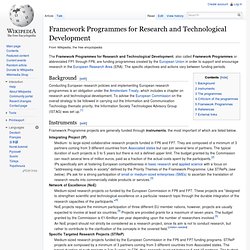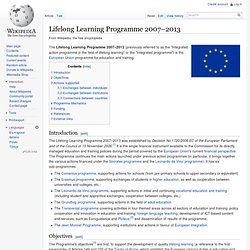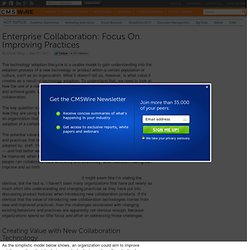

Suresh Fernando. Discover Characteristics of Effective Collaboration.
Andy Stefanovich – The Museum Mentality. E-Project Tracker. Framework Programmes for Research and Technological Development. The Framework Programmes for Research and Technological Development, also called Framework Programmes or abbreviated FP1 through FP8, are funding programmes created by the European Union in order to support and encourage research in the European Research Area (ERA).

The specific objectives and actions vary between funding periods. Background[edit] Conducting European research policies and implementing European research programmes is an obligation under the Amsterdam Treaty, which includes a chapter on research and technological development. To advise the European Commission on the overall strategy to be followed in carrying out the Information and Communication Technology thematic priority, the Information Society Technologies Advisory Group (ISTAG) was set up.[1] Instruments[edit] Framework Programme projects are generally funded through instruments, the most important of which are listed below. Integrating Project (IP) Network of Excellence (NoE) Specific Targeted Research Projects (STReP) Leonardo da Vinci programme. The Leonardo da Vinci programme is a European Commission funding programme focused on the teaching and training needs of those involved in vocational education and training (VET).

The programme is part of the European Commission's Lifelong Learning Programme 2007-2013[1] and aims to build a skilled and mobile workforce across Europe. Aims[edit] The programme aims to enhance the competitiveness of the European labour market by helping European citizens to acquire new skills, knowledge and qualifications and have them recognised across borders. It also supports innovations and improvements in vocational education and training systems and practices. Lifelong Learning Programme 2007–2013. The Lifelong Learning Programme 2007–2013 (previously referred to as the "Integrated action programme in the field of lifelong learning" or the "Integrated programme") is the European Union programme for education and training.

Introduction[edit] The Lifelong Learning Programme 2007–2013 was established by Decision No.1720/2006/EC of the European Parliament and of the Council of 15 November 2006.[1] It is the single financial instrument available to the Commission for its directly managed education and training policies during the period covered by the European Union's current financial perspective. The Programme continues the main actions launched under previous action programmes (in particular, it brings together the various actions financed under the Socrates programme and the Leonardo da Vinci programme). It has six sub-programmes: Objectives[edit] Actions supported[edit] Exchanges between individuals[edit] These include (for example):
COIN Integrated Project: Collaboration and Interoperability for Networked Enterprises. Tools for distributed, collaborative product innovation: The EU-Pro... Collaboration. Collaboration. Enterprise Collaboration: Focus On Improving Practices. The technology adoption lifecycle is a usable model to gain understanding into the adoption process of a new technology or product within a certain population or culture, such as an organization.

What it doesn’t tell us, however, is what value it creates as a result of technology adoption. To understand that, we need to look at how the use of a new technology or product affects the ability to perform tasks and achieve goals. Let's look at this specifically in the context of enterprise collaboration. The key question is not if people have adopted a certain technology, but rather how they are using it and how new and improved practices are being adopted. For an organization that seeks to improve its operations and management, the adoption of a certain technology isn’t really interesting unless it creates value. Quotation. Luis von Ahn: Massive-scale online collaboration. Innovation Expert John Seely Brown on New Ways of Learning in a Rapidly-Changing World.
Michael Nielsen: Open science now! Roger McNamee: Six ways to save the internet. Will Massive Collaboration Work for You? Technology often offers the "next big thing.

" Since the dot-com crash of 2001, we've seen a reemergence of tech-enabled innovation under the banner of Web 2.0, then Enterprise 2.0, and now Government 2.0. We're evolving from top-down, hierarchical controls to greater reliance on coordination through peer-to-peer communications and negotiation. There's been an explosion of activity in blogs, wikis, Facebook, LinkedIn, Twitter, Flickr and YouTube. Web content has moved from institutional production to a stage where 70 percent now comes from individuals.
Enthusiasts believe that collaboration is essential for any enterprise in the 21st century. But is this really the "next big thing"? Some in the field are decidedly skeptical. Others, however, are hugely enthusiastic. Recently, we ran a roundtable session to gain public-sector perspective on massive collaboration. My answer, after working with this group, is that "it will be huge. " 1. 2. 3. 4. 1. 2.